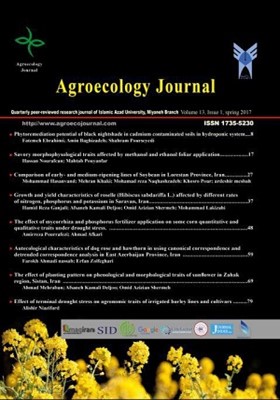The effect of GA3 on quality and quantity characteristics of Viola odorata Linn
Subject Areas : Agroecology JournalSaeid Davazdahemami 1 * , Forough Mortazaeinezhad 2 , Maryam Parvaresh 3 , Marziyeh Allahdadi 4
1 - Natural Resources Research Department, Isfahan Agricultural and Natural Resources Research Center, Agricultural Research Education and Extension Organization (AREEO), Isfahan, Iran.
2 - Department of Horticulture, Isfahan (Khorasgan) Branch, Islamic Azad University, Isfahan, Iran
3 - Department of Horticulture, Isfahan (Khorasgan) Branch, Islamic Azad University, Isfahan, Iran
4 - Ph. D. in AgroEcology, Department of Plant Ecophysiology, Faculty of Agriculture, University of Tabriz, Tabriz, Iran
Keywords: Sweet violet , Secondary metabolites, Flower, Plant growth regulators,
Abstract :
Sweet violet (Viola odorata Linn.) is a perennial plant belonging to the Violaceae family that is not only known as a medicinal and ornamental plant but also widely used in the cosmetics industry. In order to investigate the effect of different concentrations of gibberellin on the quantitative and qualitative properties of Sweet violet flowers, an experiment was conducted in a randomized complete block design with three replications at Islamic Azad University of Khorasgan (Isfahan). Treatments were different levels of gibberellin with three concentrations of 0 (control), 200 and 400 ppm. Results showed that the application of gibberellin at 400 ppm significantly increased flower number, flower diameter, flowering duration, anthocyanin content, flavonoids, chlorophyll and UV absorptions compared to control treatment. There was no significant difference in terms of anthocyanin, chlorophyll b and carotenoids between the treatment of 200 ppm gibberellin and control treatment. Flower diameter, flower number, flowering duration and anthocyanin content of flowers at two concentrations of hormone (200 and 400 ppm) showed similar results. Regarding the medicinal use of sweet violet flowers, it is recommended to use hormonal treatments to increase the number of flowers and secondary metabolites of this plant.

